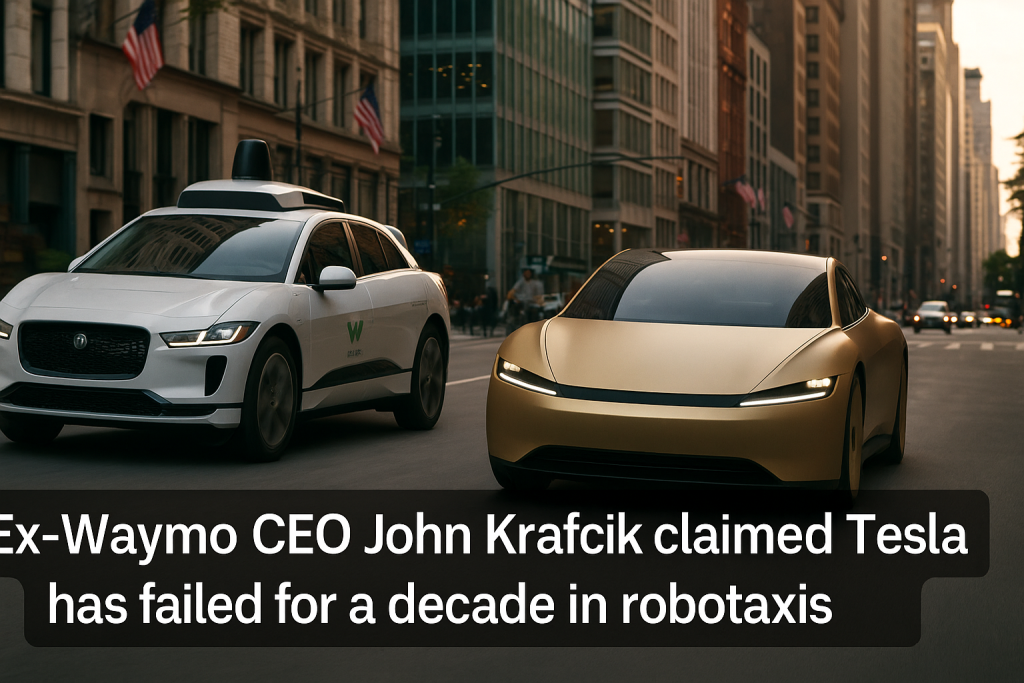Ex-Waymo CEO John Krafcik Says Tesla ‘Never Competed’ and ‘Utterly and Completely Failed’ at Robotaxis
The self-driving car industry is boiling over with sharp words and fierce competition, especially between Tesla and Waymo. In a recent volley, former Waymo CEO John Krafcik took a direct shot at Tesla, bluntly stating that Elon Musk’s company has “never competed with Waymo” and has “utterly and completely failed” over the past decade to deliver a real robotaxi service.

Krafcik’s comments come amid growing debate over the two companies’ fundamentally different approaches to autonomous driving. Waymo, owned by Alphabet (Google’s parent company), relies on a costly tech stack , a $180,000 suite of LiDAR, radar, cameras, and AI, heavily dependent on pre-mapped, 3D-rendered environments.
Tesla, on the other hand, is trying to do it all with “Computer Vision AI” using only cameras and neural nets, aiming for a scalable ~$30,000 system that can work anywhere without the need for detailed pre-mapping.
Waymo’s advantage today is real but expensive: Waymo’s robotaxis are operating today in places like Phoenix and San Francisco, where you can order a ride through your phone. But the price to make it happen is eye-watering, with Waymo vehicles looking like mobile sensor towers. They are accurate, but the system isn’t easily scalable without heavy investment in mapping and sensors everywhere they want to operate.
Tesla’s approach looks riskier , but also way more disruptive: Tesla is betting on vision-only autonomy powered by end-to-end neural networks. No LiDAR. No radar. Just a fleet of sleek vehicles that rely on what they “see” to drive themselves , more like how a human drives.
Although Tesla hasn’t yet launched its promised robotaxi network, the company is inching closer with its Full Self-Driving (FSD) beta programs and planned Robotaxi vehicle expected to be announced in 2026.
And let’s be honest: when you look at the cars themselves, it’s night and day. Waymo’s robotaxis , largely based on retrofitted Jaguars and other OEM vehicles , are jammed with clunky-looking hardware.
Tesla’s vehicles, meanwhile, are designed from the ground up for style, efficiency, and soon, autonomy. Once Tesla fully ramps up its robotaxi service, a lot of these criticisms from Krafcik could age poorly , very poorly.
Cost and scale will be the big deciders: While Waymo burns through capital to meticulously pre-map areas and maintain expensive sensor arrays, Tesla is building a global fleet that could update and improve overnight via software. If Tesla can deliver even 80% of Waymo’s current robotaxi performance but at a fraction of the cost , and in more locations , Tesla could leapfrog Waymo in a big way.
At the end of the day, Waymo’s slow, methodical approach gave them the early lead in robotaxi services. But Tesla’s audacious, high-risk vision could let them blow right past Waymo once they hit scale. If that happens, John Krafcik’s words might not just age badly , they’ll probably be the tech equivalent of a “hold my beer” moment.
Would you bet against Elon Musk figuring it out? Not a smart move historically.